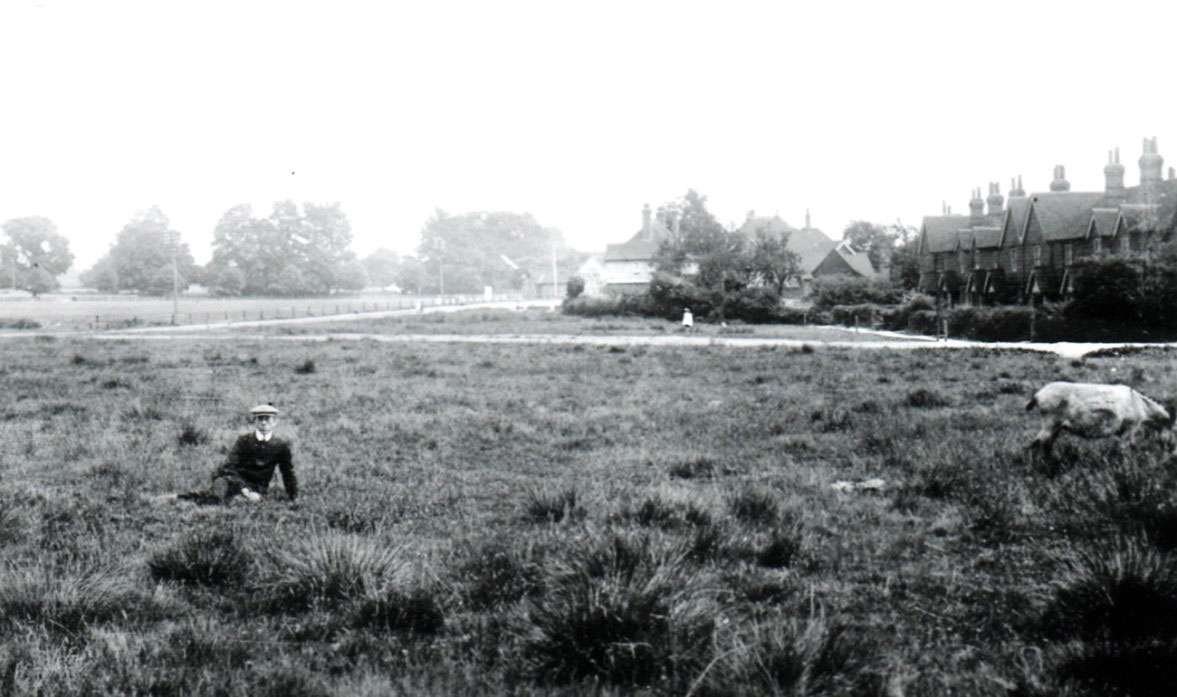
Cranleigh Common in 1911 where Ian’s great grandfather David Stedman lived at no. 4 Parkgate Cottages (photograph courtesy of Mike Rackley)
I was born in Cranleigh in 1939, though we moved soon afterwards to Guildford. My father, Cecil George Stedman, went to Burma in 1942 to fight the Japanese, and Aunt’s husband also went abroad, so my mum and I went to live with her during the war. She lived in Worcester Road in one of the ‘£10 down houses’ which meant you put a £10 deposit down and paid off the rest as a mortgage. By the end of the mortgage of course, you owned the freehold property.
From her home I went to school in Stoughton, right next door to the Queen’s barracks there. It was a beautiful school and I loved it. It’s amazing how later in my life I still have a connection to the barracks. After the war finished we moved back to Cranleigh.
I first started collecting medals that I found in the junk shops in Guildford. There used to be a nice shop just under the arch at the bottom of North Street. I would go there and pay 15 shillings for them. I was probably in my early 20s at that point. I was interested in military items long before that though. When I was a teenager I would go to jumble sales in Cranleigh village and buy books all about the military just to read the detail and information they contained.
Later, I trained as a book binder at Guildford Art school, then took an apprenticeship in Guildford. Books and memorabilia became part of my life.
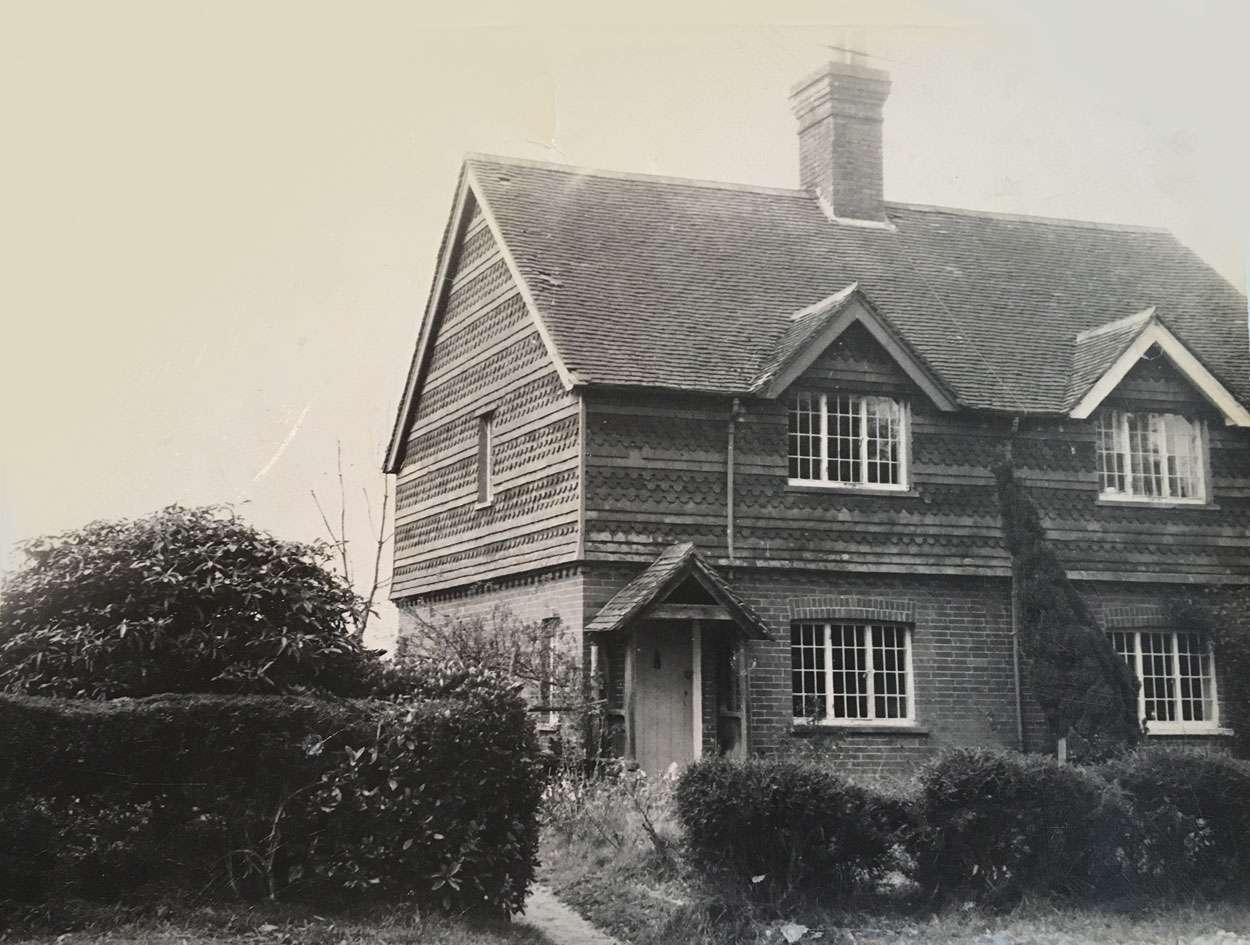
Ian’s grandfather, William, lived at 3 Broadhurst Cottages, Smithwood Common
When I got married my wife and two sons and I lived in 3 Broadhurst Cottages, Smithwood Common, until 1974.
I met so many people on the Common who had served in the 1st World War. Arthur Eade was the first person I ever talked to and there were others. One of the chaps was a gunner, who was in the artillery. He died but I knew his sister and she let me have his medals.
In 1975 I became a member of the Orders and Medals Research Society (OMRS), a London firm, and would go up to London to Baldwin’s where I bought a lot of my early items. I used to visit all the Medal dealers in London.
Occasionally I did some book binding work for some of them. I didn’t keep that up for long though because the travelling took so much time and if I obtained say a trolley full of books, they were very heavy to carry around.

The troops from the 6th Corps & Cavalry Division of the British Army of the Rhine, commanded by General Sir W.R. Robertson. The Right Honourable Winston S. Churchill inspected the Battalion that day as part of a competition on Monday 18th August 1919, in Cologne, which they won
To me reading the history of the wars is vital. Wars like the Great War, books about the Indian Mutiny. In my collection I have a lot of things from India, from all the campaigns and battles.
Much of my collection I purchased in the sixties and some items were given to me from people in the village, friends of my parents, who knew of my interest in history. I’ve collected hundreds of books that I can’t even count how many. I make a point of reading them for obvious reasons.
My interest in collecting Queen’s Royal West Surrey Regiment was awakened mainly because the Regiment was a part of the local area and I knew so many people that served in it. My cousin, George Cecil Stedman, was in Burma during the 2nd World War serving in the Queen’s Regiment. He used to tell me dreadful stories when I was a little boy. Like one day a jeep full of Japanese officers came down the hill through the forest. The Gurkhas were hiding up in the trees, waiting for them and at the right moment they dropped down on them and killed them all. The Gurkhas were proficient fighters and knew what they were doing.
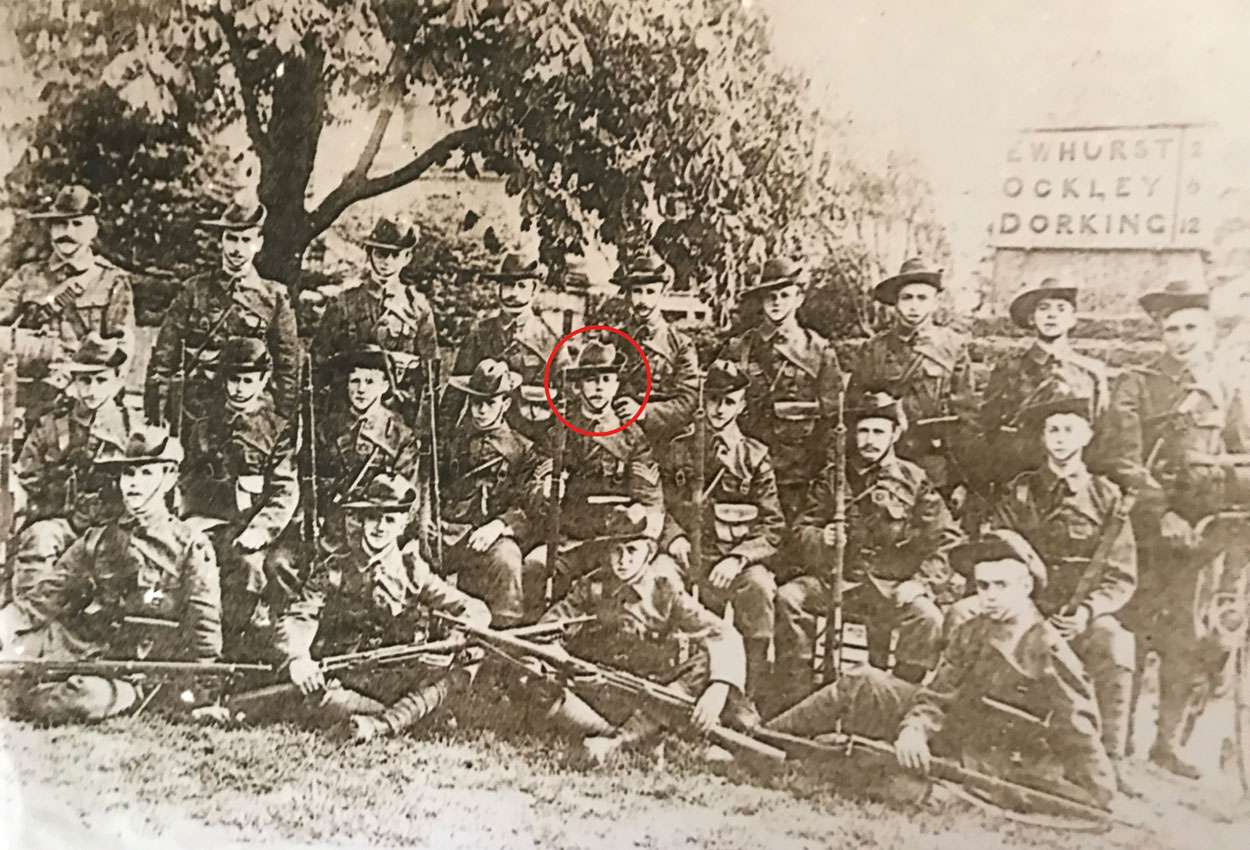
Edward Dicker at Cranleigh obelisk with the Territorials (circled)
There was another particular friend I knew – David Gettings, whose father was killed in Burma. My cousin George Cecil Stedman, who had fought in Burma alongside him, went to visit Mr Getting’s widow, to tell her how he’d seen her husband die in action. He was killed by a Japanese sniper as he reached up to put his shirt on.
Years later David and I were chatting about the details of how his father had died, and he said his Mum had never mentioned it to him. Sometimes people cannot talk about these events because they are too painful. But we need to remember them and the sacrifices that were made for us. Behind all this collection of books and medals are stories of real lives; local people who’ve lived and died serving their country.
Sometimes I come across things quite by accident; one particular item came from one of my dad’s cousins. His name was Edward Dicker and he lived on the Guildford Road originally, with his father. He was Cranleigh’s first retained fireman and I have got his medals, including all his fire brigade medals and memorabilia. He was a volunteer in the Territorials. I have a photo that was taken of him at the Cranleigh obelisk. He’s sitting on a bench with the Dorking company of the Queen’s. They’re all on bicycles and had cycled all the way from Dorking to Cranleigh.
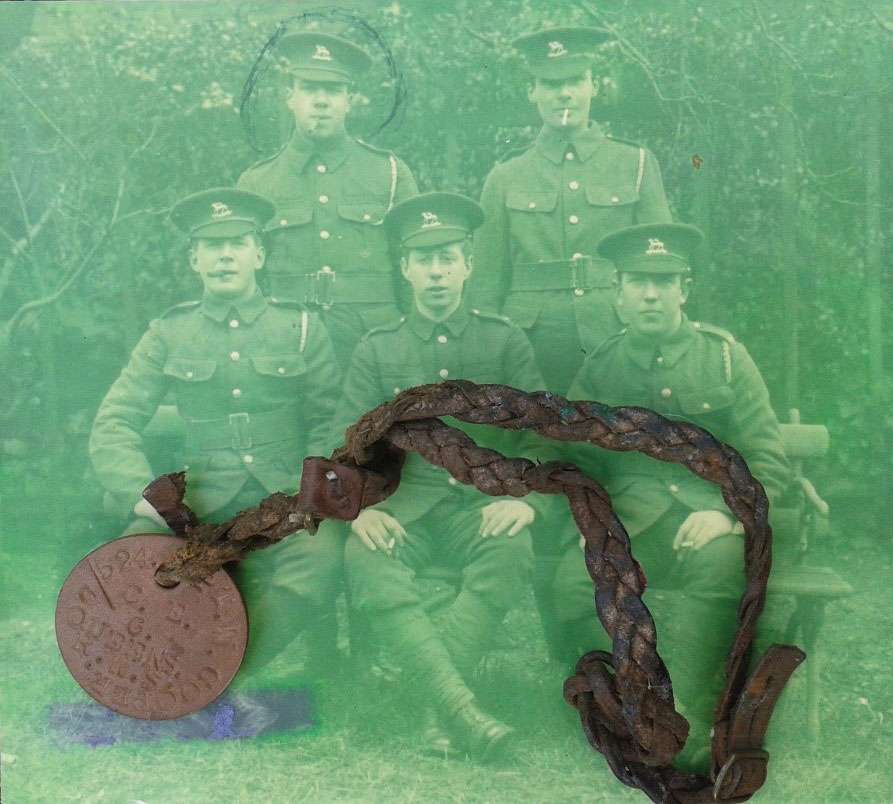
Identification disk and photo of William Cooper (circled). Do you recognise the other men in the photograph?
I value everything in my collection from something like that – a photograph of a particular moment in a man’s life to some things of great value say on the open market. It’s a matter of perspective how each is valued. I would never sell any of it though.
Whenever I add something like a medal to my collection it’s always of additional interest if there’s a photograph or something personal that links the item to the person and their life. I’ve bought a Victory medal recently that was presented to a chap who is buried in Guildford cemetery. I was subsequently given a photograph of him and that’s a nice addition to the collection.
I discovered another chap who was born in Alton and had lived in Guildford. At the time of his death, when he was killed in France, he had no surviving family relatives. He left his medals to his girlfriend, who lived in Guildford. I have got all the papers she signed to say she accepted his medals, and other accompanying papers. She had to go to an official and sign for them all. Obviously, she didn’t marry him because he’d died in action, but he was a Guildford man and his name is on the Alton War Memorial. Rather a sad love story as she was the only one he had left. The interesting fact is that all these papers are held in The National Archives.
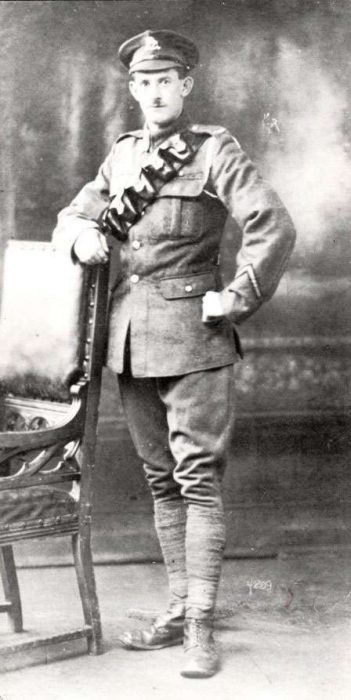
Arthur Eade in uniform
Another is a letter written to me concerning two Cranleigh men in the 1st Battalion of the Queen’s Regiment. One of them was a William Cooper. He wrote to me in 1977 and described how he was standing next to the second gentleman, Alfred Cracket as he was killed at Arras in 1917. William Cooper himself was taken prisoner, but survived and lived to be over 81, despite having a bullet lodged near his lung.
Apparently, Alfred Cracket went to throw a bomb at the enemy and a Saxon officer shot him in the attempt. On the other side of that letter it mentions Arthur H. Eade. He was a lovely fellow and it was he who got me interested in the 1st World War, in which his uncles had fought. He lived on Smithwood Common and was a good friend of my father’s.
Arthur Eade survived the war and gave very graphic descriptions of trench warfare and the daily life of a soldier. On several occasions men with him were killed, but fortunately he came through the war with barely a scratch.
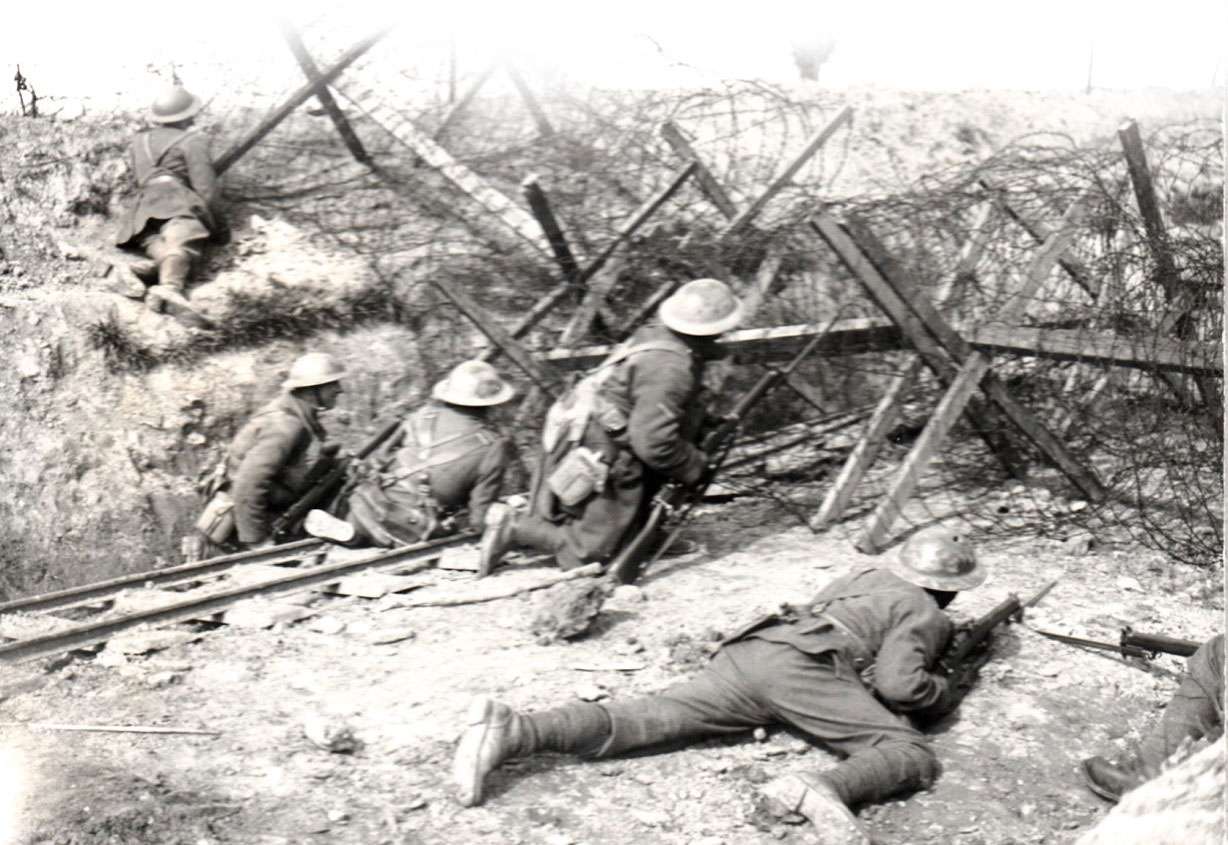
A picquet of the 10th Queen’s behind a barbed wire road block on Wytschaete Ridge in April 1918
There was a time in 1917 he told me when he was serving on Mount Po, in Italy. It was Christmas time with snow and everything. Out of the blue a cake arrived from his mother for Christmas. They thoroughly enjoyed sharing it together. Can you imagine it? In the middle of the war, a cake arriving from Cranleigh and it’s snowing, then there’s ‘peace and goodwill’ in the air. Shortly afterwards he was posted back to France and put into the front line. They were attacked by the Germans in 1918 – the big attack. In the battle reports, it says they fired over 2 million rounds into the Germans, 2 million rounds – that’s a lot of bullets among 2 battalions of troops!
Another thing he told me was they never did any bayonet fighting, ever! It just never happened because they didn’t get close enough. Often these days, the media portray it all incorrectly but when you read the books you’ll discover very few soldiers got into action with single-handed man-to-man fighting in the 1st World War.
Arthur didn’t ever get wounded, save a cut finger from barbed wire once, that’s all. He was trained as a Lewis gunner. All the infantry towards the end of the war were trained as Lewis gunners, as they were more useful. A rifle was sufficient but a Lewis gun was more efficient as a killing machine. After the war he was sent to Cologne, where he stayed as part of the army of occupation. Cologne was the main placement area for the British troops. He returned later to Cranleigh and lived here all his life.
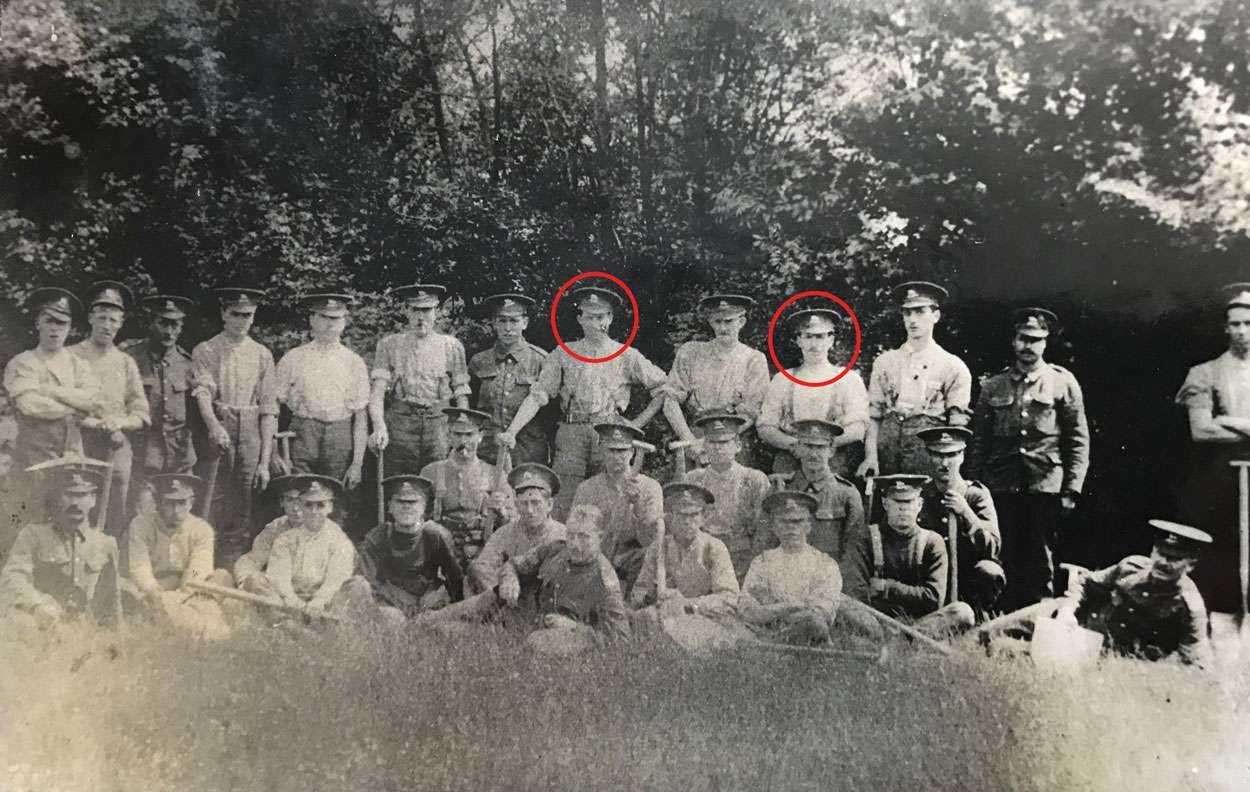
Arthur Eade circled (far right) and his neighbour (circled left)
Arthur is pictured (3 photos above) in his smart uniform wearing his bandolier, which held all his ammunition. If you look more closely, you can see he’s got an upside-down stripe which indicated he’d served 4 years in the Army, during the 1st World War.
I’ve also got photographs of the 10th (Lambeth) Battalion of the Queen’s who mostly originated from London. There are 2 people from Cranleigh in this photo on page 18. One lived in Mead Road and the other is Arthur Eade again. They were next door neighbours in the village. The photo shows them digging a trench just before they went to France. Strangely enough the other chap knew my Dad very well. My father did all his decorating for him.
There’s another picture of Arthur behind barbed wire (2 photos above) It was taken during 1st World War of the 10th Queen’s Battalion during the final stages of the war. They are behind a trench block and are moving up to attack.

1566, 2nd entry: twin Stedman boys christened (Cranleigh parish register in Surrey History Centre). Since then, in the 19th century, Ian’s great-grandfather, David, lived at 4, Park Gate Cottages. Ian’s grandfather, William, moved to 3, Broadhurst Cottages, Smithwood Common, and his father, Cecil, bought 12, The Mount in the 1930s
Local families were represented in various regiments. Joe Cheesman (later Chairman of Mann’s) was in the 3rd Glosters. I have got all his army papers. He went out to France in the middle of the big German offensive of 1918, and was transferred to the 8th Glosters as reinforcement, but was taken prisoner. The funny thing is, when his family wrote for news of him, the Army didn’t know where he was at all! They found him in the end, but it took a very long time. He was lucky to be alive because not many survived.
I also knew Chris Brand who was a Director of Mann’s. When he died, his wife gave me all his medals. He was in the machine gun regiment in the Queen’s, during the 1st World War. On one occasion I had done some book-binding for him in Mann’s and got talking to him. He introduced me to John Womack, regarding him as an office boy then! Well as it happened I knew John’s wife Mrs Womack, who served on the Isle of Wight in the Radar during 2nd World War in The Women’s Royal Air Force (WRAF).
Chris Brand’s brother Bill was the only man in Cranleigh who joined the Oxfordshire and Buckinghamshire Light Infantry who trained here. He was wounded in France and transferred to the RAF. I have got his set of RAF wings. In the Middle East he became an expert on carpets, so Mann’s opened a carpet department where the café is now.
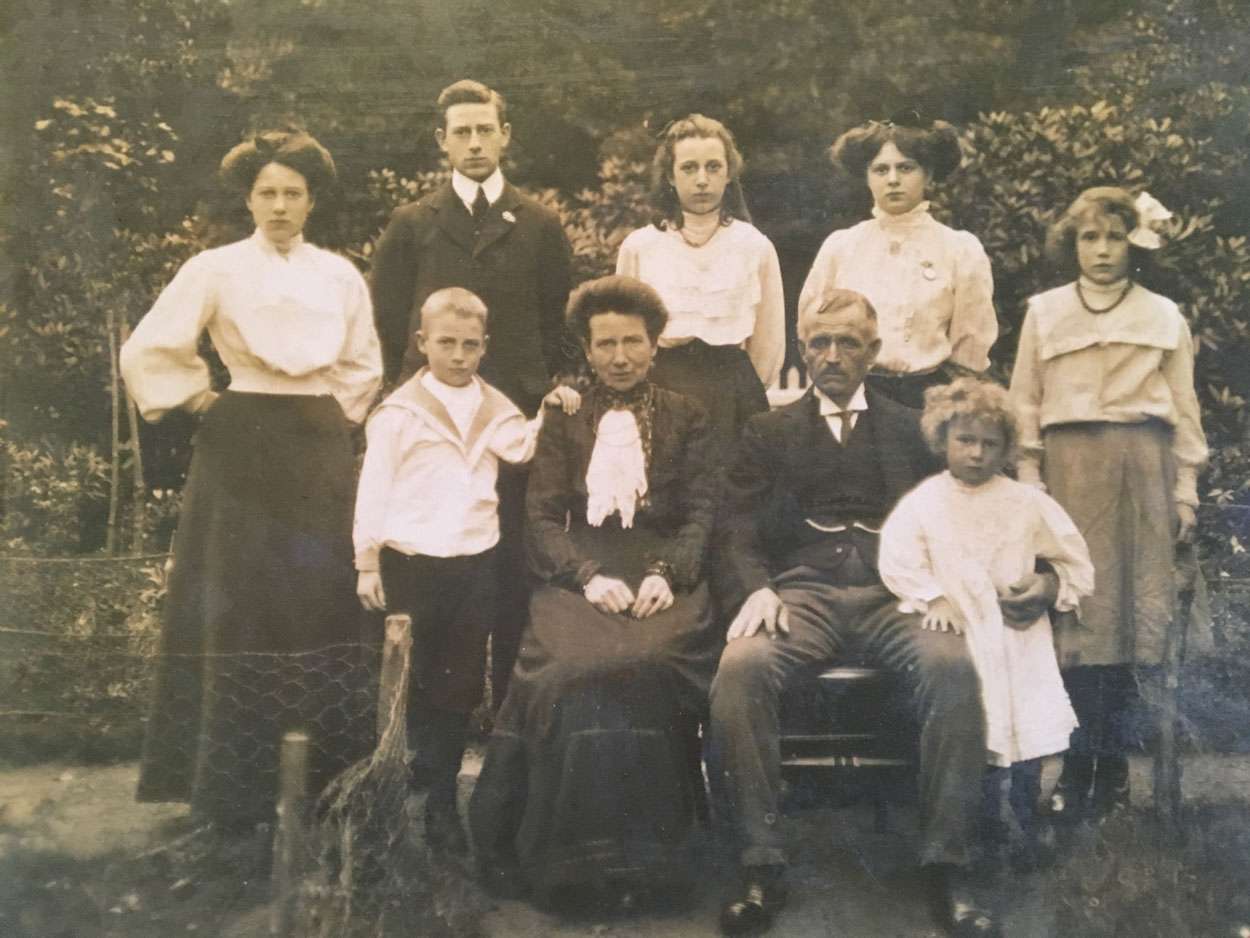
William Stedman (b.1865) son of David, and his wife Alice (nee Lassam) centre. They were married on Christmas Day 1866 in St.Nicolas church and are seen here with their seven children, (back) Gertrude, William, Florence, Ethel, Alice, (front) Cecil and Wilhelmena at 3, Broadhurst Cottages, Smithwood Common
There’s one other interesting point. People locally have heard of Robert Collins, a butcher from Cranleigh who was killed in the Great War. He was wounded serving on the front line and while recovering from his injuries in hospital in Norwich, died of a thumb infection.
I discovered a photograph in the Imperial War Museum, which is so much like him that I am sure it is him. It was incredible to find this picture of the 6th Queen’s where there’s this one man standing, eating bread in the trench during the winter. On close inspection it looks so much like him, it’s unbelievable. I had to look twice! I knew him and his family well and have a photograph of him as a soldier from his family so I could compare. But this photograph came from the Imperial War Museum. I had a friend who used to work in the Imperial War Museum. He got me through to the photographic section as he was in charge.
I don’t buy as much nowadays unless I see something special and it’s priced within reason. It would be lovely to place my collection in a local museum in Cranleigh perhaps, but there’s no opportunity for that at the moment.
There’s always the risk if it’s not recognised in this way, that it may be sold to other collectors or get moved on, broken up and dispersed.

Cecil Stedman’s birth certificate, dated 29th November 1900

Cecil Stedman’s Sunday School Prizes, 1910-12
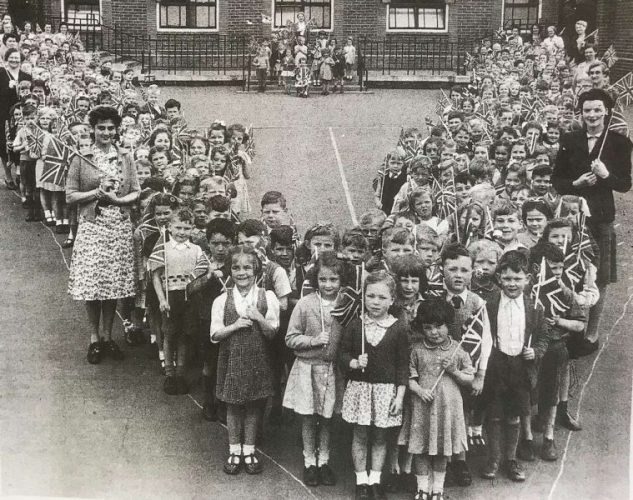
VE Day May 8th 1945. V for victory, Stoughton Infants School Guildford, Ian Stedman is circled near the front
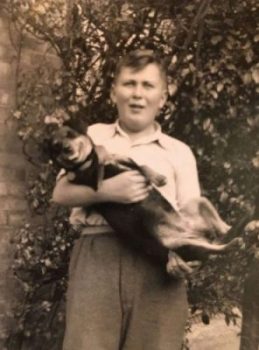
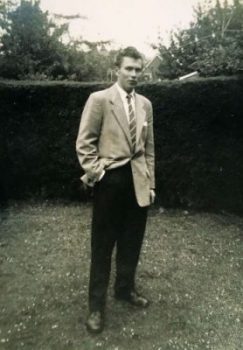
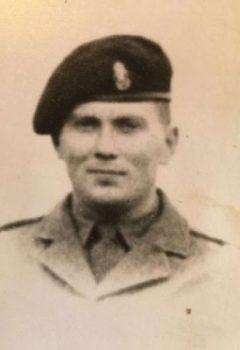
Ian Stedman in the garden, 12 The Mount as a Young Adult and as a National Serviceman
Editor’s note: Perhaps we need to create a ‘Cranleigh Museum’ to house Ian’s collection along with many other similar artefacts in a local building; like the old Cranleigh Hospital – a building already steeped in history. With the Arts Centre, pubs,restaurants, coffee shops and nearby parking facilities perhaps there’s an opportunity to start one? Or rebuild the old Cranleigh windmill on the Common and house the museum there. ‘Everything has to start with an idea’. Answers on an email please.











